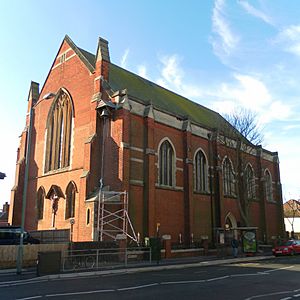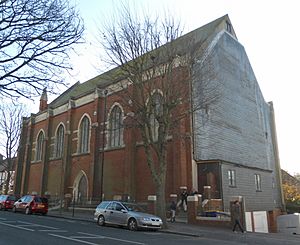St Mary and St Abraam Coptic Orthodox Church, Hove facts for kids
Quick facts for kids St Mary and St Abraam |
|
|---|---|

The church from the northeast
|
|
| 50°49′51.89″N 0°9′21.04″W / 50.8310806°N 0.1558444°W | |
| Location | Davigdor Road, Hove, East Sussex, BN3 1RF |
| Country | |
| Denomination | Coptic Orthodox Church |
| Website | www.stmary-stabraam.co.uk |
| History | |
| Founded | 1994 |
| Dedication | Mary and Abraham of Egypt |
| Dedicated | 1909 (as Anglican church); 1994 (as Coptic Orthodox church) |
| Architecture | |
| Architect(s) | Clayton & Black (original building); Antonius Saad, Brighton (alterations) |
| Style | Early English Gothic Revival |
| Completed | 1909 |
| Administration | |
| Division | The Coptic Orthodox Patriarchate |
The St Mary and St Abraam Church is a Coptic Orthodox Church. It is located in Hove, a part of the English city of Brighton and Hove. This church is one of about 27 Coptic Orthodox churches found across the British Isles. The Coptic community in Brighton and Hove started in 1990. Four years later, in 1994, the church moved to its current home on Davigdor Road. This road is right on the border between Brighton and Hove.
Contents
The Church Building's History
The building where the church is now located is quite old. It was originally an Anglican church called St Thomas the Apostle. It was built in 1909 by a company from Brighton called Clayton & Black. This company designed many buildings in the area.
Building Style and Features
The church building is tall and made of red bricks. It is built in an Early English style. This style often features pointed arches. The church has a very large pointed-arch window on its eastern side. On the northern side, where the entrance is, there are five smaller windows.
From Anglican to Coptic Church
The last service for St Thomas the Apostle was held on January 17, 1993. The church was officially closed on July 20, 1993. Even though the building was in poor condition, the Coptic Orthodox Church bought it soon after. The old church's parish (its local area) joined with All Saints Church nearby. Some special artworks from St Thomas the Apostle were moved to St Mary's Church, Kemptown.
The Church Under Coptic Ownership
Many of the first members of the Coptic community in Hove were people who had to leave their homes because of the Second Sudanese Civil War. Because of this, many people from Sudan attend the church. Also, many Copts who originally came from Egypt worship here. Around the year 2000, there were about 4,000 Sudanese worshippers, and the church had two priests.
A Special Dedication
The former leader of the Coptic Orthodox Church, Pope Shenouda III, visited Hove. He held a special ceremony to dedicate the church on September 23, 1994. This ceremony officially made it a Coptic Orthodox church. In 1995, the church was also given permission to hold marriage ceremonies. An addition to the building was approved in 1998.
Amazing Interior Features
The church has some very special things inside. In 2000, a huge screen called an iconostasis was put in. It is made of mahogany and oak. This screen is about 7.5 meters (25 feet) tall. People say it is the tallest such structure in the world! Small parts of it were carved one by one in Egypt. Then, they were brought to Hove and put together in just six hours by volunteers. This was done just in time for the Easter celebrations that year. In Eastern Christianity, Easter is celebrated using a different calendar than in Western Christianity.
Pope Shenouda III came back to the church on August 13, 2000. He dedicated the iconostasis. This screen shows the Last Supper, Jesus Christ, and other holy figures on 24 icons. Father Zakaria Botros, an Egyptian priest who was in charge of the church then, also painted a large icon of Christ above the altar. He did this even though he had no formal art training.
A Time of Disagreement
In 2003, Father Botros left the church. This made many members of the church upset. They believed he was forced to leave. Some people protested, and Pope Shenouda III had to talk to hundreds of churchgoers. He spoke to them using a mobile phone link all the way from Egypt.
Coptic Orthodox Churches in the UK
St Mary and St Abraam was the first Coptic Orthodox church in the south of England outside of London. There are other Coptic churches in the British Isles. Some of these are in Kensington and Croydon in London. Others are in places like Lapworth in Warwickshire, Solihull in the West Midlands, Manchester, Newport in Wales, Kirkcaldy in Scotland, and Dublin in the Republic of Ireland.
Currently, there are about 30,000 members of the Coptic Orthodox Church in the United Kingdom. Another 5,000 Copts are part of the British Orthodox Church. Together, these communities are served by 27 Coptic Orthodox churches.
See also
- List of places of worship in Brighton and Hove
- Coptic Orthodox Church in Britain and Ireland


